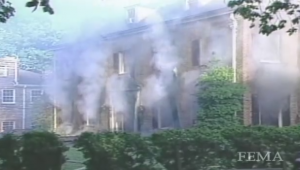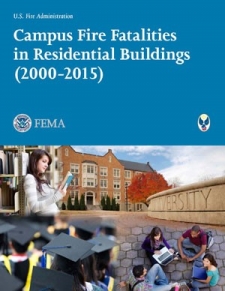
November 21, 2015 (Washington D.C.)--A new report from the U.S. Fire Administration highlights factors that led to the deaths of 118 college students in 85 fatal fires from 2000 through 2015, The report found many of these tragedies were preventable. Key findings include:
- Alcohol was a factor in 76% of cases.
- Smoke alarms were either missing or tampered with (disconnected or battery removed) in 58 %t of fatal campus fires.
- Smoking was the leading cause of fatal campus fires, responsible for 26%.
- Other common causes included overloading power strips or extension cords, cooking, unattended candles, and arson.
- 67% of the victims were males.
- Fire sprinklers were not present in any of the 85 fatal campus fires.
 Where and when did these fires occur?
Where and when did these fires occur?
- 70 percent of fatal campus fires occurred on the weekend (Friday, Saturday and Sunday).
- 73 percent of the fatal fires occurred between midnight and 6 a.m.
- April was the peak month (13 percent) for fatal fires in campus housing.
- The vast majority (94%) of these fatal fires occurred off-campus.
Safety officials can use these study findings to improve on- and off-campus fire injury prevention programs.
The U.S. Fire Administration recommends everyone should have a comprehensive home fire protection plan that includes smoke alarms, fire sprinklers, and practicing a fire escape plan.
Safety tips for students
There are several specific causes for fires on in on- and off-campus college housing, including cooking, candles, smoking and overloaded power strips. For most students, the last fire safety training they received was in grade school, but with new independence comes new responsibilities. It is important that both off-campus and on-campus students know their fire risks and prevention actions that could save their lives.
Cooking
Cook only where it is allowed.
Keep your cooking area clean and free of anything that can burn.
Keep an eye on what you are cooking, especially if you are cooking at high temperatures.
If a fire starts in a microwave, keep the door closed and unplug the unit.
Candles
Place candles in sturdy holders.
Never leave a burning candle unattended.
Keep candles away from anything that can burn.
Use safe flameless candles.
Smoking
Make sure cigarettes and ashes are out. Never toss hot cigarettes butts or ashes in the trash can.
Use deep, wide ashtrays. Place ashtrays on something sturdy and hard to burn.
After a party, check for cigarette butts, especially under cushions. Chairs and sofas catch on fire fast and burn fast.
Don’t smoke when you have been drinking or are drowsy.
Electrical safety
Keep lamps, light fixtures, and light bulbs away from anything that can burn.
Never use an extension cord with large appliances, like a refrigerator.
Do not overload outlets.
Use only surge protectors or power strips that have internal overload protection.
Download the free report and campus fire safety outreach materials at www.usfa.fema.gov/prevention/outreach/college.html
Here is a brochure for students with campus fire prevention tips.
View a video: https://youtu.be/yMQQhMztyuw









Recent comments